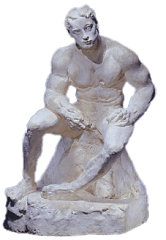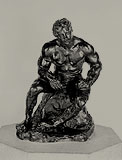|
In 1901, Rodin allowed a young man to improvise on the pose of 'The
Thinker' while the artist created 'The American Athlete'.
 The French
Master was greatly impressed by the well-developed
physical appearance of his model, Samuel Stockton White III. The latter was a
member of the Princeton University gymnastics team and was introduced to
Rodin during a stay in Paris, who asked him to pose for him. The
transatlantic co-operation was positively covered in the American press;
in an article of 16 March 1902 in the Philadelphia Sunday Press, White
recalled his first sittings in Rodin's atelier: The French
Master was greatly impressed by the well-developed
physical appearance of his model, Samuel Stockton White III. The latter was a
member of the Princeton University gymnastics team and was introduced to
Rodin during a stay in Paris, who asked him to pose for him. The
transatlantic co-operation was positively covered in the American press;
in an article of 16 March 1902 in the Philadelphia Sunday Press, White
recalled his first sittings in Rodin's atelier:
"When I first posed for him, he complimented me most highly and said that my chest, arms, shoulders, and back were beautiful, and that, from him, means so much."
 Over
a period of several years, White used to visit Rodin in Paris; Rodin
modeled two slightly different versions, one with the head looking straight and the other with the head turned to the left.
The first cast of the first version was presented to White. Over
a period of several years, White used to visit Rodin in Paris; Rodin
modeled two slightly different versions, one with the head looking straight and the other with the head turned to the left.
The first cast of the first version was presented to White.
In a letter to Mrs Margery Mason, dated 25 May 1949, White
recollected his meetings with the sculptor :
I posed for him in 1901 and 1904 for the statuette which he called, "The Athlete."
(...)
How I came to pose for him is rather interesting; while I was attending Cambridge University in England, I joined Sandow’s academy in London as I was very interested in physical development, hand balancing, etc. and won the Sandow Gold Medal for Development. During this period, I was spending some time in Paris and a friend of mine suggested that I offer myself as model to Rodin; the idea interested me and I paid a visit to Rodin who complimented me on my development and accepted me as a model.
After trying me in several standing poses, he suggested that I take a pose of my own which I did, — seated — the pose being somewhat similar to "The Thinker."
'The American Athlete' is just one of many cases, in
which Rodin preferred to work with dancers, acrobats or strong men (like
the carnival artist Cailloux, who posed for 'The
Falling Man' and 'The Shade'),
instead of employing professional models with their studied academic
poses.
|
 The French
Master was greatly impressed by the well-developed
physical appearance of his model, Samuel Stockton White III. The latter was a
member of the Princeton University gymnastics team and was introduced to
Rodin during a stay in Paris, who asked him to pose for him. The
transatlantic co-operation was positively covered in the American press;
in an article of 16 March 1902 in the Philadelphia Sunday Press, White
recalled his first sittings in Rodin's atelier:
The French
Master was greatly impressed by the well-developed
physical appearance of his model, Samuel Stockton White III. The latter was a
member of the Princeton University gymnastics team and was introduced to
Rodin during a stay in Paris, who asked him to pose for him. The
transatlantic co-operation was positively covered in the American press;
in an article of 16 March 1902 in the Philadelphia Sunday Press, White
recalled his first sittings in Rodin's atelier:
 Over
a period of several years, White used to visit Rodin in Paris; Rodin
modeled two slightly different versions, one with the head looking straight and the other with the head turned to the left.
The first cast of the first version was presented to White.
Over
a period of several years, White used to visit Rodin in Paris; Rodin
modeled two slightly different versions, one with the head looking straight and the other with the head turned to the left.
The first cast of the first version was presented to White.